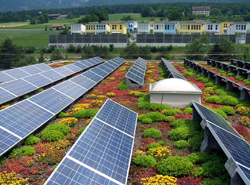Solar in Jersey City - Here and Now
/The time is right for Solar in New Jersey, and in Jersey City we have a lot of opportunity. Whether you are a condo owner, home owner, or have a small or large business, if you own a rooftop or parking lot with unobstructed sunlight, you have a money making machine. Add to that the local jobs you create, and the environmental benefits...what's not to like?

Cruise around Jersey City from above with Google Maps and you’ll see dozens of solar installations, from the 30 panels on my rooftop on Wayne Street to the giant installations atop Macy’s and ShopRite. We can expand this to hundreds of installations and make a significant dent in the city’s Carbon Footprint, reduce the Urban Heat Island Effect, and create hundreds of local jobs in the process.
If you want to go solar, first make sure your roof is in good shape. Panels last 30 years, and so will a good commercial roof. A typical residential roof needs resurfacing every 15 years, so you’ll need to replace your roof once during that time, but why do it twice? And consider combining with a green roof, which can last 50-100 years, provide much needed insulation, and reduce storm water overflow.
Second, decide whether you want to own the system, or simply rent your roof. This second option, called a PPA (Power Purchase Agreement), lets a company install panels on your roof, and sell you the power at a specified price over the next 20 years. You’ll generally save 20-30% on your electric bill now, and even more in the future.
On Tuesday, November 4th, 7pm at City Hall, we’ll have three presentations giving an overview of solar installation and financing, how community solar can accelerate installations in your neighborhood, and advocacy opportunities for legislation to encourage and streamline solar in Jersey City. Event details: SJC Eat Meet and Talk
There’s more information on Solar in our Resources page in the Energy section.
Don’t own a roof? Don’t have time for advocacy? Still want to lower your carbon footprint and support Clean, Renewable energy? You can choose an Energy Supplier that uses Wind and Solar Farms to power your apartment and only pay a few extra dollars per month. Track down your PSEG account number and you can make the switch online in just a few minutes. Learn about the NJ Clean Power Choice program here: Clean Energy Providers.




Building a sustainable wardrobe doesn’t mean sacrificing style—it just means making smarter choices. Whether you’re shopping second-hand, supporting ethical brands, or getting creative with upcycling, every small step helps reduce waste and protect the environment.